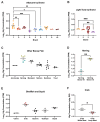Variability of Mercury Concentrations Across Species, Brand, and Tissue Type in Processed Commercial Seafood Products
- PMID: 40559900
- PMCID: PMC12196803
- DOI: 10.3390/toxics13060426
Variability of Mercury Concentrations Across Species, Brand, and Tissue Type in Processed Commercial Seafood Products
Abstract
Mercury (Hg) is a global health concern due to its prevalence, persistence, and toxicity. Numerous studies have assessed Hg concentrations in seafood, but variability in reported concentrations highlights the need for continued monitoring and stricter regulations. We measured total Hg (tHg) in 148 pre-processed, packaged seafood products purchased in Raleigh, North Carolina, using thermal decomposition-gold amalgamation atomic absorption spectrophotometry. Products were grouped into three categories based on trophic ecology and physiology: (1) tuna, (2) other bony fish, and (3) shellfish and squid. Among tuna, albacore had the highest average tHg (396.4 ng/g ± 172.1), while yellowfin had the lowest (68.3 ng/g ± 64.7). Herring (54.0 ng/g ± 23.2) and crab (78.2 ng/g ± 24.1) had the highest concentrations in the other two groups. One can of albacore exceeded the FDA action level of 1 part per million (1.3 ppm or 1300 ng/g). Brand differences were significant for both albacore and light tuna, with Brand 1 consistently showing higher Hg levels. Comparisons to FDA data (1990-2012) suggest Hg concentrations in tuna have remained stable over the past two decades. This study underscores the variability of Hg concentrations across species and brands and the need for continued monitoring to protect consumers.
Keywords: canned food; fish; mercury; seafood; tuna.
Conflict of interest statement
Author Leah Segedie is employed by Bookieboo LLC, DBA “MAMAVATION.com”. The remaining authors declare that the research was conducted in the absence of any commercial or financial relationships that could be construed as a potential conflict of interest.
Figures



Similar articles
-
A systematic review and meta-analysis of metal concentrations in canned tuna fish in Iran and human health risk assessment.Food Chem Toxicol. 2018 Aug;118:753-765. doi: 10.1016/j.fct.2018.06.023. Epub 2018 Jun 18. Food Chem Toxicol. 2018. PMID: 29913231
-
Direct composite resin fillings versus amalgam fillings for permanent posterior teeth.Cochrane Database Syst Rev. 2021 Aug 13;8(8):CD005620. doi: 10.1002/14651858.CD005620.pub3. Cochrane Database Syst Rev. 2021. PMID: 34387873 Free PMC article.
-
Mercury in oceanic upper trophic level sharks and bony fishes - A systematic review.Environ Pollut. 2023 Feb 1;318:120821. doi: 10.1016/j.envpol.2022.120821. Epub 2022 Dec 9. Environ Pollut. 2023. PMID: 36509349
-
Antibody tests for identification of current and past infection with SARS-CoV-2.Cochrane Database Syst Rev. 2022 Nov 17;11(11):CD013652. doi: 10.1002/14651858.CD013652.pub2. Cochrane Database Syst Rev. 2022. PMID: 36394900 Free PMC article.
-
Signs and symptoms to determine if a patient presenting in primary care or hospital outpatient settings has COVID-19.Cochrane Database Syst Rev. 2022 May 20;5(5):CD013665. doi: 10.1002/14651858.CD013665.pub3. Cochrane Database Syst Rev. 2022. PMID: 35593186 Free PMC article.
References
-
- WHO Mercury and Health. 2017. [(accessed on 18 February 2025)]. Available online: https://www.who.int/news-room/fact-sheets/detail/mercury-and-health.
-
- WHO 10 Chemicals of Public Health Concern. 2020. [(accessed on 18 February 2025)]. Available online: https://www.who.int/news-room/photo-story/detail/10-chemicals-of-public-....
-
- Beckers F., Rinklebe J. Cycling of mercury in the environment: Sources, fate, and human health implications: A review. Crit. Rev. Environ. Sci. Technol. 2017;47:693–794. doi: 10.1080/10643389.2017.1326277. - DOI
-
- Basic Information about Mercury|US EPA. [(accessed on 18 February 2025)]; Available online: https://www.epa.gov/mercury/basic-information-about-mercury.
Grants and funding
LinkOut - more resources
Full Text Sources
Miscellaneous

